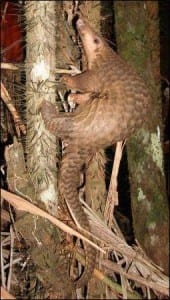Specimen of the Week: Week Thirty-Four
By Emma-Louise Nicholls, on 4 June 2012
 You’ve just finished work. You’re tired. Achy. You want to go home. Then comes the inevitable issue ‘what shall we have for dinner’? You want dinner, you’re looking forward to dinner, you know you’ll enjoy dinner, but you just don’t have the energy to think about it; ‘What ingredients do we have’, ‘What will the supermarket be undoubtedly sold out of at this late hour’ (if you have a long commute like me.) Everyone likes to be in control, but just sometimes, it feels nice for someone else to say ‘let’s have this’, and the decision’s done, you can go back to checking your eyelids for holes on the train. In a similar vein, I thought that this week, maybe it would be nice for someone else to help me decide what the Specimen of the Week should be. ARKive (http://www.arkive.org) heroically stepped up and said they’d get their followers to vote for their favourite. EXCELLENT!! So, by VERY popular demand, here is this week’s Specimen of the Week, as chosen by the wonderful public. It is…
You’ve just finished work. You’re tired. Achy. You want to go home. Then comes the inevitable issue ‘what shall we have for dinner’? You want dinner, you’re looking forward to dinner, you know you’ll enjoy dinner, but you just don’t have the energy to think about it; ‘What ingredients do we have’, ‘What will the supermarket be undoubtedly sold out of at this late hour’ (if you have a long commute like me.) Everyone likes to be in control, but just sometimes, it feels nice for someone else to say ‘let’s have this’, and the decision’s done, you can go back to checking your eyelids for holes on the train. In a similar vein, I thought that this week, maybe it would be nice for someone else to help me decide what the Specimen of the Week should be. ARKive (http://www.arkive.org) heroically stepped up and said they’d get their followers to vote for their favourite. EXCELLENT!! So, by VERY popular demand, here is this week’s Specimen of the Week, as chosen by the wonderful public. It is…
**!!!The Asian Pangolin!!!**
1) There are eight species of pangolin, four that inhabit Asia, like our Specimen of the Week, and four that are from Africa. The species from Asia are the Chinese pangolin, the Sunda or Malayan pangolin, the Indian or thick-tailed pangolin, and the Philippine pangolin. Although the common names for all four species originate from geography, only the Philippine pangolin has the courtesy to non-confusingly do what it says on the tin, and be from the Philippines. The other three species are actually found all over, each one inhabiting a number of different countries. Highly misleading, tut tut.
2) If a pangolin extended its tongue to its full length, it would be longer than its body! Even more impressive than that, is that in most species the base of the tongue is not attached in the mouth as in humans, or even in the head, but rather, deep down inside their chest. Crazy.
3) The pangolin is also known as the scaly anteater. It is not hard to imagine why (see image left). The scales are made of keratin, the same as our fingernails. This scaly armour, that protects them from predators, covers the whole of the top and sides of the animal. Just like a knight’s suit of armour, it is heavy. In fact the scales make up about 20% of a pangolin’s body-weight.
4) Have you ever laughed whilst drinking and had it come out of your nose? Not pleasant. Pangolins would agree, they don’t like their food going up their nose any more than we like drink coming out of ours. As their food (ants and termites) have a tendency to move, sticking your face into a swarm of insects is likely to result in clogged nostrils. So pangolins have developed the skill to shut their ears and nostrils at will, meaning the pesky insects only enter via the desired orifice; the mouth.
5) Pangolins do not have teeth and therefore cannot chew their food. To compensate for this, they swallow stones instead. Not instead of food, they swallow stones instead of chewing. The food is then ground up in the stomach which aids digestion.
We have a number of pangolins here at the Grant Museum, three preserved in fluid and two taxidermy specimens, like the one shown above. They’d all be very excited to meet you next time you pop in, and make sure you look out for the Specimen of the Week plaque!
 Close
Close




